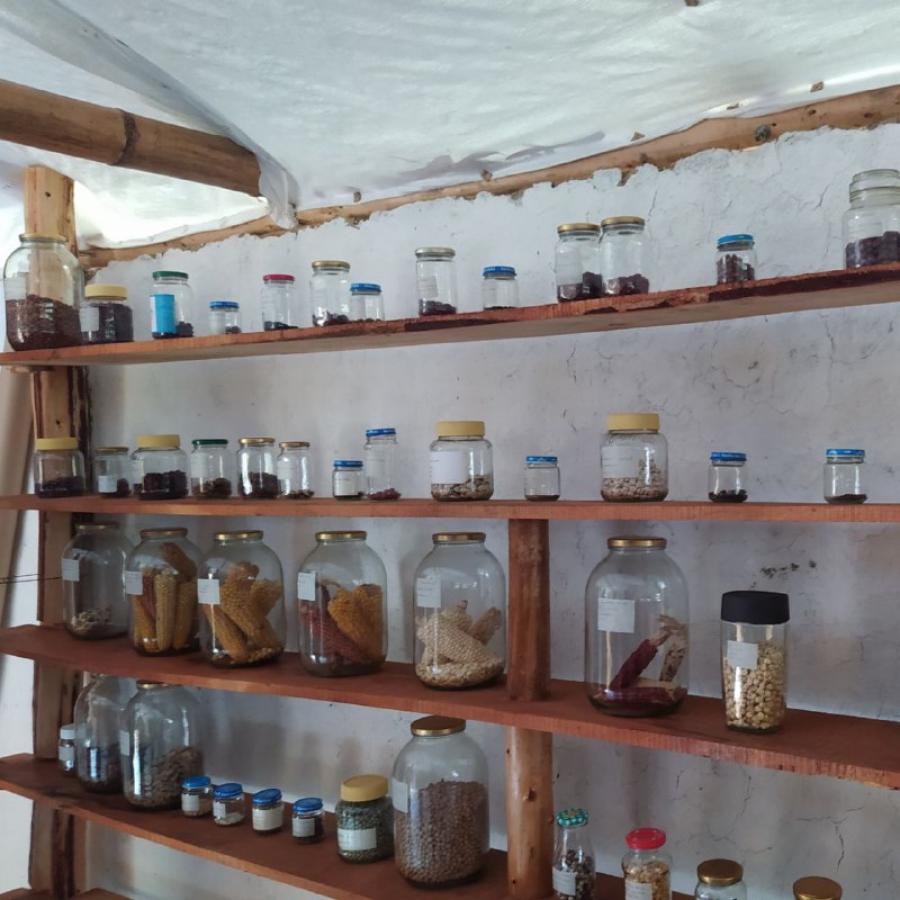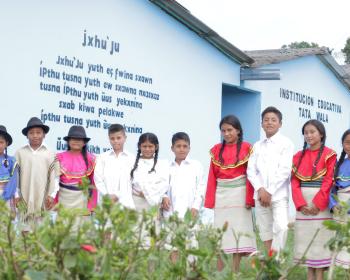For the indigenous people of Andean Bolivia who have been growing and consuming the coca leaf for several thousand years, the rising demand for cocaine in the United States is rapidly restructuring their economic and social relations. In recent years, underground, illegal economic activities have emerged on a grand scale. Surpassing most other legal economic endeavors, these underground activities are distorting patterns of economic development and the social well-being of the Andean peasant majority.
While Bolivia produces approximately 40 to 45 percent of the world's supply of coca leaf and coca paste, the Chapare tropical rain forest area in the Department of Cochabamba alone supplies 70 percent of the nation's coca leaf crop. Farmers from the highlands who migrated here cleared tens of thousands of hectares of forested lands to grow the plant on small plots.
Coca-paste making and international trafficking, however, traditionally has been the domain of elites such as the cattle ranchers of the Beni Department, the agro-business groups within the Department of Santa Cruz and a small group within the Bolivian military. But in 1982, when a major military drug trafficking group lost national power and a civilian, democratic government took office, the Cochabamba peasants began making coca paste because of its incomparable profits and wages.
The growing international demand for cocaine has stimulated increased coca leaf production in Bolivia by these small farmers. The United States Drug Enforcement Agency estimates the flow of cocaine into the United States has climbed from 35 metric tons in 1981 to 85 metric tons in 1985. Bolivian coca leaf production likewise jumped from 35 metric tons to 120 metric tons between 1978 and 1985 according to official Bolivian government figures.
Meanwhile, elites have continued their coca-paste production and some have turned to the production of pure cocaine, which Colombians previously controlled. These groups enjoy greater political protection than the peasants and have the capital and other resources to engage in direct international cocaine trafficking.
Economic Depression Stimulates Production
Bolivia's economic depression and a severe drought in the mountain provinces during the 1982-83 growing season, has made the coca/cocaine trade attractive. Caught in an international debt-repayment squeeze, Bolivia's gross national production since 1980 has fallen by 17 percent, its per capita consumption by 30 percent and its per capita income by 20 percent. During this same period, unemployment doubled. In addition, inflation went from 297 percent in 1982 to 328 percent in 1983. In 1984 it soared to 2,800 percent and then to about 10,000 percent during 1985 (Central Bank of Bolivia). Small farmers in all regions of Bolivia continue to suffer declining terms of trade from such inflation - a trend that began in the late '60s.
Against this background, it might appear that the flow of economic benefits from the coca/cocaine trade has been unambiguously positive. The 35,000 producers of coca leaves in the Chapare region can each net up to $9,000 annually from the production of 2.2 acres. The next most profitable crop in this area, citrus, earns producers only $500 from the same size plot. In addition, small farmers benefit from the coca leaf's unusual characteristics which make it a "wonder crop." Fine-tuned over a millennium in the Andean ecosystem, coca grows relatively well on poor soil, has comparably few problems with blight and pests, four to five harvests annually and a life expectancy of 18 years. Its light weight and non-perishable qualities also make it ideal for low-cost, long-range mountain transport and its production requires no imported petro-chemical products or expensive institutional credit.
Highland peasants who do not own land in the Chapare are increasing migration to the area to earn wages in coca-leaf production activities and as pisadores. These workers stomp the coca leaves with their feet in the clandestine paste-making laboratories.
Wages for coca leaf production are higher than for any other cash crop in Bolivia, and wages for paste-making are greater even than wages earned in urban areas; they are also six to eight times higher than any other skilled or unskilled labor in the legal, rural economy.
Despite the increasing income for small farmers in the Chapare, the coca/cocaine boom is leading them and their country down an illusory development path. The coca trade has induced peasants to shift land from food production for such crops as rice, bananas, yucca, maize, citrus and pineapples to coca leaf production. This mono-cropping trend leads to greater dependency on purchased foodstuffs, raises food prices and creates shortages of these crops. This could, however, stimulate food production in other areas of Bolivia.
In the coca-growing and paste-making areas of the Chapare and upper Cochabamba Valley during 1984 and 1985, inflation has reached the highest levels in Bolivian history. In the Chapare town of Shinahota, the cost of a piece of bread has risen to $1.00 and the daily cost of living has ranged from $20 to $100 in recent years (Los Tiempos, July 18, 1985). The regional urban capital city of Cochabamba, once one of Bolivia's least expensive cities, is presently the most expensive.
Coca Trade Creates Labor Shortages in Highlands
In the Chapare, wage labor is displacing traditional forms of exchange that have provided stability, continuity and even equity to peasant communities. Reciprocal labor patterns and mutual support structures, characteristics of local Andean life, are breaking down, and there is a marked increase in the monetarization of the peasant economy (Flores, 1984). In the highland areas, such as the upper Cochabamba Valley and Norte de Potosi, there are reports of labor shortages for such crops as potatoes and maize, because so many peasants have fled to the proliferating "cocaine factories" to work as pisadores.
Coca Trade Destroys Environment
In the pursuit of quick profits the peasants' rush to produce coca leaves and coca paste also is taking its toll on the Cochabamba region's ecosystem (Flores, 1984). In the upper Cochabamba Valley, recent reports indicate that chemicals used in making coca paste sometimes are dumped into the streams and irrigation ditches contaminating agricultural lands and livestock. The basic quality of life remains poor, as well. Most communities in the Chapare still have no potable water, electricity and indoor plumbing (Flores, 1984). In Bolivia, these services are provided by the Ministry of Health and the regional public development corporations, who are not receiving revenues from the coca trade. Serious levels of infant mortality, malnutrition and gastrointestinal illnesses remain prevalent.
Coca Leaf Losing Traditional Cultural Value
While becoming a commodity exclusively for cash exchange and commercial gain, the coca leaf, the sacred plant of Andean society, is losing its traditional cultural value in the Chapare. For years its uses in religious rituals and daily exchange between family, friends and strangers have conveyed friendship and hospitality. Chewing the coca leaf, which contains a mild stimulant, provides energy for arduous tasks in agriculture and mining, and is a lightweight source of protein. In addition, 87 percent of the inhabitants of the small towns and rural communities in Bolivia use the coca leaf for health purposes. Used by itself, the coca leaf is known to provide some 40 remedies and in combination with other plants, some 30 other remedies.
But now the price of the coca leaf has risen so high, more than a million and a half Bolivian peasants can no longer easily afford it. In addition, the quality of the leaves in the licit local markets has declined.
While coca-leaf chewing is waning, smoking pitillo, coca paste mixed with tobacco, has become widespread among pisadores and poor peasant families. Drug traffickers often remunerate pisadores with pitillos, and because of the exposure in their own clandestine paste-making laboratories - a veritable homemade kitchen industry - families have also become consumers.
Coca paste has more impurities than the pure cocaine hydrochloride used in the United States and is presumed to cause many serious health effects. Bolivian medical researchers are investigating the health impact upon the pisadores, whose feet come into contact with kerosene over many hours. The researchers' preliminary reports are extremely alarming. While stomping on the leaves in a tedious and monotonous crushing process, the pisadores are often given alcoholic beverages, coca paste, a special meal and regional music, all of which are used "to increase their productivity."
Trade Breeds Corruption and Violence
The expanding drug trade has pulled the peasantry into illegal activity as pisadores and owners of makeshift cocaine factories, as well as smugglers of coca leaves and various processing chemicals such as kerosene and sulphuric acid. Peasant women have entered en masse into prostitution in the drug-making zones and into petty commerce with the processing chemicals. They also sometimes cook for the workers in the cocaine factories.
The repression against the drug trade in Bolivia falls disproportionately upon the peasants because of their lack of political and economic power. Drug-related arrests and detentions have led to overcrowding in the major detention centers. Meanwhile, the larger trafficking interest groups are seldom arrested or prosecuted because of their ability to curry favor with or pay off the Bolivian police, judges, prison guards and assorted local officials.
The coca/cocaine boom in Bolivia has stepped up violence in rural areas as well because of officials' efforts to repress the illegal trade and widespread arms trafficking. Arms have become necessary to protect the coca-paste factories and the transport of the same by the traffickers. In recent years 300 drug-related murders were reported in Bolivia (Los Tiempos, August 9, 1984).
The illegal cocaine processing and trafficking, while violating international treaties and national laws, breeds not only violence but corruption among the public institutions employing the local public officials, the police force and the military. It has also brought sinister criminal traffickers from Colombia, Brazil and Venezuela into the rural areas of Cochabamba, Santa Cruz and Beni in Bolivia.
Finally, as a consequence of burgeoning economic interests, the rapidly spreading coca/cocaine boom is causing considerable problems for leaders of local peasant unions. Bolivia has one of the most effective national indigenous social movements in Latin America, but cocaine-related rivalries, charges and countercharges, threaten to weaken the federation's cause and legitimacy.
Bolivia, a poor, debt-ridden country, is caught in the grip of an expanding drug economy and a mirage of economic development. Despite the substantial flow of dollars, jobs and income, it has been at the cost of major social and cultural changes. Similar to other so-called "boom" periods in Latin American history, the country's peasantry absorbs in diverse and perverse forms the major costs of these changes. Given Bolivia's increasing economic dependency in the world economy, it is unlikely that this trend will slow down or that conditions will improve in the near future - not at least until cocaine consumption in the United States declines substantially.
Article copyright Cultural Survival, Inc.



